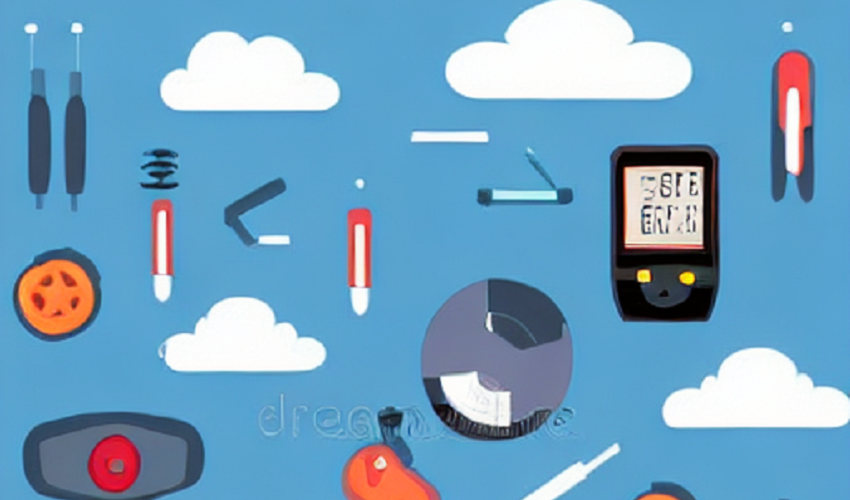What is diabetes?
Diabetes is a chronic medical condition characterized by high levels of sugar (glucose) in the blood. It occurs when the body is unable to produce enough insulin or cannot effectively use the insulin it produces. Insulin is a hormone that helps regulate blood sugar levels and allows cells to use glucose for energy. There are two main types of diabetes: type 1 diabetes, which is usually diagnosed in childhood or adolescence, and type 2 diabetes, which is more common in adults and is often associated with lifestyle factors such as obesity and lack of physical activity. Managing diabetes is crucial to prevent complications and maintain overall health, and incorporating yoga into the treatment plan can be beneficial in balancing blood sugar levels naturally.
The impact of diabetes on blood sugar levels
Diabetes has a significant impact on blood sugar levels, causing them to fluctuate and become difficult to control. When someone has diabetes, their body either does not produce enough insulin or does not use it effectively. Insulin is a hormone that helps regulate blood sugar levels by allowing glucose to enter the cells for energy. Without proper insulin function, glucose builds up in the bloodstream, leading to high blood sugar levels. This can have serious health consequences and increase the risk of complications associated with diabetes. Managing blood sugar levels is crucial for individuals with diabetes, and incorporating yoga into their routine can be a natural and effective way to achieve balance and stability in blood sugar levels.
The importance of managing blood sugar levels
Managing blood sugar levels is crucial for individuals with diabetes. High blood sugar levels can lead to a range of complications, including nerve damage, kidney disease, and heart problems. By practicing yoga, individuals can help balance their blood sugar levels naturally. Yoga poses, such as forward bends and twists, can stimulate the pancreas and improve insulin sensitivity. Additionally, yoga helps reduce stress and promote relaxation, which can also have a positive impact on blood sugar control. Incorporating yoga into a diabetes management plan can be an effective way to support overall health and well-being.
Understanding Yoga
What is yoga?
Yoga is a holistic practice that originated in ancient India. It combines physical postures, breathing exercises, and meditation to promote overall well-being. The word ‘yoga’ means union, and it represents the connection between the mind, body, and spirit. In the context of diabetes, yoga can be a powerful tool for managing blood sugar levels naturally. Regular practice of yoga postures and breathing techniques can help improve insulin sensitivity, reduce stress, and enhance overall health. By incorporating yoga into their daily routine, individuals with diabetes can achieve better blood sugar control and improve their quality of life.
The benefits of yoga for overall health
Yoga offers numerous benefits for overall health, making it an ideal practice for individuals with diabetes. Regular yoga practice can help balance blood sugar levels naturally by reducing stress and promoting relaxation. It also improves insulin sensitivity, which is crucial for managing diabetes effectively. Additionally, yoga helps improve cardiovascular health, increase flexibility and strength, and enhance mental well-being. By incorporating yoga into their routine, individuals with diabetes can experience improved overall health and well-being.
How yoga can help in managing diabetes
Yoga can be a powerful tool in managing diabetes by helping to balance blood sugar levels naturally. Regular practice of yoga postures, breathing exercises, and meditation can improve insulin sensitivity and reduce insulin resistance. Yoga also helps to reduce stress, which is a common trigger for elevated blood sugar levels. Additionally, certain yoga poses, such as forward bends and twists, stimulate the pancreas and promote the production of insulin. Incorporating yoga into a diabetes management plan can not only improve blood sugar control but also enhance overall well-being and quality of life.
Yoga Poses for Diabetes
Mountain Pose (Tadasana)
Mountain Pose, also known as Tadasana, is a foundational yoga pose that can be beneficial for individuals with diabetes. This pose helps to improve blood circulation and increase awareness of the body. By standing tall with feet grounded and arms relaxed, Mountain Pose helps to promote a sense of stability and balance, which can be particularly beneficial for individuals with diabetes who may experience fluctuations in blood sugar levels. Additionally, practicing Mountain Pose can help to reduce stress and promote a calm state of mind, which can have a positive impact on overall blood sugar management. Incorporating Mountain Pose into a regular yoga practice can be a valuable tool for individuals with diabetes in managing their condition and promoting overall well-being.
Downward-Facing Dog (Adho Mukha Svanasana)
Downward-Facing Dog, also known as Adho Mukha Svanasana, is a popular yoga pose that can be beneficial for individuals with diabetes. This pose helps to stretch and strengthen the entire body, including the arms, shoulders, legs, and back. It also helps to improve blood circulation and stimulate the digestive system, which can aid in balancing blood sugar levels. Practicing Downward-Facing Dog regularly can help individuals with diabetes manage their condition by promoting overall health and well-being.
Seated Forward Bend (Paschimottanasana)
Seated Forward Bend, also known as Paschimottanasana, is a beneficial yoga pose for individuals with diabetes. This pose involves folding forward from a seated position, which helps to stretch the entire back of the body, including the hamstrings, calves, and spine. By practicing Seated Forward Bend regularly, it can help improve blood circulation, stimulate the digestive system, and reduce stress levels. Additionally, this pose can also help to relieve tension in the lower back and improve flexibility. When performed mindfully and with proper alignment, Seated Forward Bend can be a valuable addition to a diabetes management routine.
Breathing Techniques for Diabetes
Deep Breathing (Pranayama)
Deep breathing, also known as Pranayama, is a powerful technique in yoga that can help individuals with diabetes in balancing their blood sugar levels naturally. By focusing on deep, slow breaths, this practice helps to activate the parasympathetic nervous system, which promotes relaxation and reduces stress. When the body is in a relaxed state, it is better able to regulate blood sugar levels and improve insulin sensitivity. Deep breathing exercises can also enhance lung function, increase oxygen supply to the cells, and improve overall well-being. Incorporating deep breathing into a daily yoga routine can be a beneficial tool in managing diabetes and promoting a healthier lifestyle.
Alternate Nostril Breathing (Nadi Shodhana)
Alternate nostril breathing, also known as Nadi Shodhana, is a powerful breathing technique that can help balance blood sugar levels naturally. This technique involves breathing through one nostril at a time while blocking the other nostril with the thumb or finger. By alternating the breath between the left and right nostrils, it is believed to harmonize the flow of energy in the body and promote a sense of calm and balance. Regular practice of alternate nostril breathing can help reduce stress, improve insulin sensitivity, and regulate blood sugar levels. It is a simple yet effective practice that can be incorporated into a daily yoga routine for individuals with diabetes.
Bee Breath (Bhramari Pranayama)
Bee Breath, also known as Bhramari Pranayama, is a powerful breathing technique that can help in balancing blood sugar levels naturally. This technique involves the production of a humming sound, similar to the buzzing of a bee. By practicing Bee Breath regularly, individuals with diabetes can experience a reduction in stress levels and an improvement in insulin sensitivity. The vibrations created during this practice stimulate the pancreas, which plays a crucial role in regulating blood sugar. Additionally, Bee Breath can enhance mindfulness and promote relaxation, contributing to overall well-being. Incorporating Bee Breath into a daily yoga routine can be an effective way to support diabetes management and maintain optimal blood sugar levels.
Diet and Lifestyle Tips
Balanced diet for managing diabetes
A balanced diet plays a crucial role in managing diabetes. It is important for individuals with diabetes to focus on consuming a variety of nutrient-rich foods that help regulate blood sugar levels. This includes incorporating whole grains, lean proteins, fruits, vegetables, and healthy fats into their meals. Additionally, portion control is key to prevent spikes in blood sugar levels. By following a balanced diet, individuals with diabetes can better manage their blood sugar levels and improve their overall health and well-being.
Importance of regular exercise
Regular exercise is crucial for managing diabetes and balancing blood sugar levels. Engaging in physical activity helps the body use insulin more effectively, which can lead to improved blood sugar control. Exercise also helps to reduce body weight and increase insulin sensitivity, both of which are important for managing diabetes. Additionally, regular exercise can improve cardiovascular health, reduce stress levels, and enhance overall well-being. It is recommended to engage in a combination of aerobic exercise, such as brisk walking or cycling, and strength training exercises to reap the maximum benefits for diabetes management.
Stress management techniques
Stress management techniques play a crucial role in managing diabetes effectively. High levels of stress can significantly impact blood sugar levels, making it difficult to maintain stable glucose levels. Engaging in regular yoga practice can be a powerful tool for managing stress and promoting overall well-being. Yoga combines physical postures, breathing exercises, and meditation, which help to reduce stress hormones and promote relaxation. By incorporating stress management techniques like yoga into your daily routine, you can enhance your body’s ability to balance blood sugar levels naturally and improve your overall quality of life.
The role of yoga in balancing blood sugar levels
Yoga plays a significant role in balancing blood sugar levels naturally. Regular practice of yoga postures, breathing exercises, and meditation can help improve insulin sensitivity and reduce insulin resistance. Additionally, yoga promotes stress reduction, which is crucial for managing diabetes as stress can elevate blood sugar levels. The combination of physical movement, deep breathing, and relaxation techniques in yoga can also enhance overall well-being and contribute to better blood sugar control. Incorporating yoga into a diabetes management plan can be a holistic and effective approach to maintain healthy blood sugar levels.
Benefits of incorporating yoga into diabetes management
Incorporating yoga into diabetes management can have numerous benefits for individuals with diabetes. Firstly, practicing yoga can help regulate blood sugar levels by improving insulin sensitivity and reducing insulin resistance. This can lead to better glycemic control and reduce the risk of complications associated with diabetes. Additionally, yoga can help manage stress and promote relaxation, which is crucial for individuals with diabetes as stress can negatively impact blood sugar levels. Furthermore, regular yoga practice can improve cardiovascular health, increase flexibility, and strengthen muscles, all of which are important for overall well-being and diabetes management. Overall, incorporating yoga into diabetes management can provide a holistic approach to managing the condition and improving overall health and quality of life.
Taking a holistic approach to diabetes care
When it comes to managing diabetes, taking a holistic approach can be highly beneficial. This means addressing not only the physical symptoms of the condition but also the emotional and mental aspects. Yoga is a powerful tool that can help balance blood sugar levels naturally. By practicing yoga regularly, individuals with diabetes can improve their insulin sensitivity, reduce stress levels, and enhance overall well-being. The combination of physical postures, breathing exercises, and meditation in yoga can have a positive impact on blood sugar control. Additionally, yoga promotes relaxation and helps manage weight, both of which are crucial for diabetes management. Incorporating yoga into a comprehensive diabetes care plan can lead to better blood sugar control and a higher quality of life.




